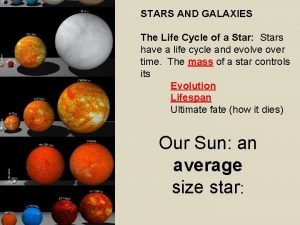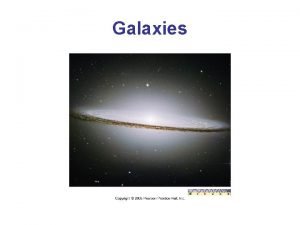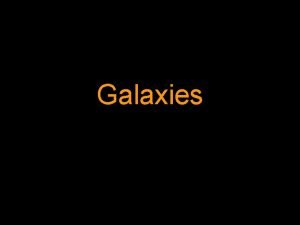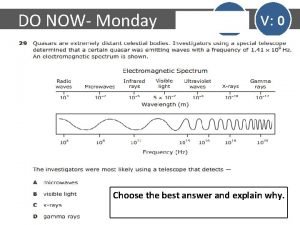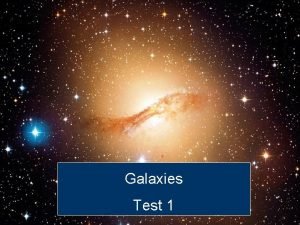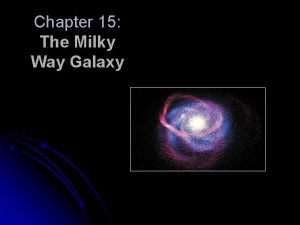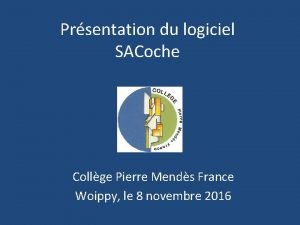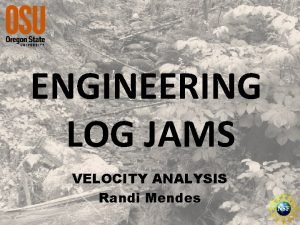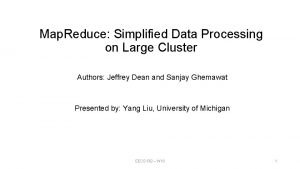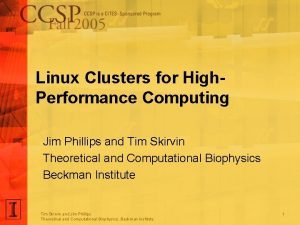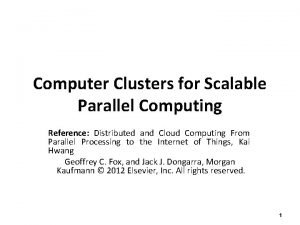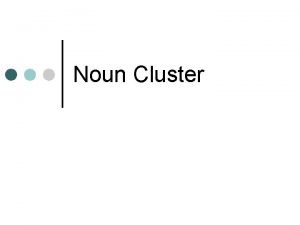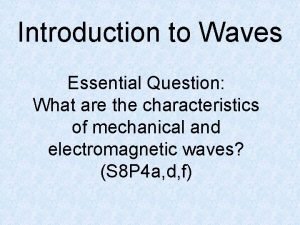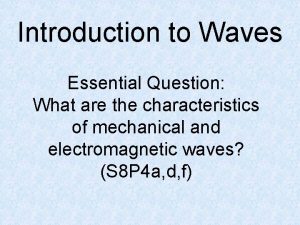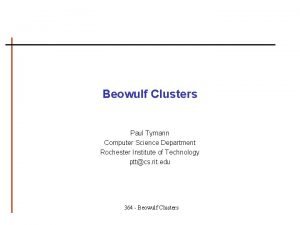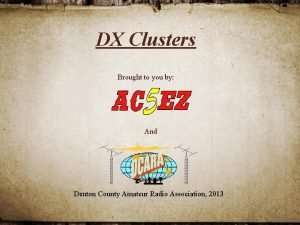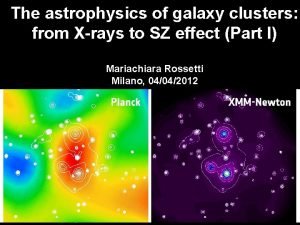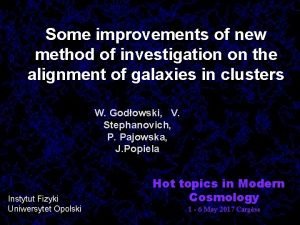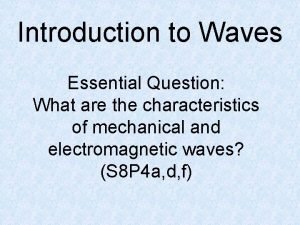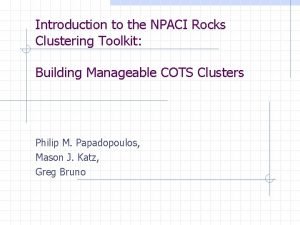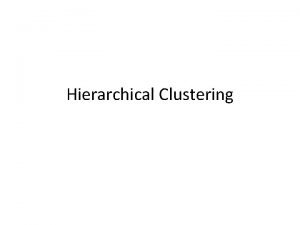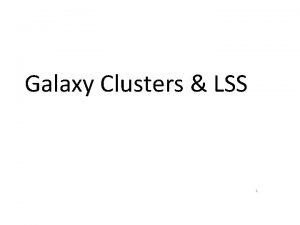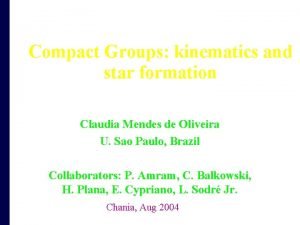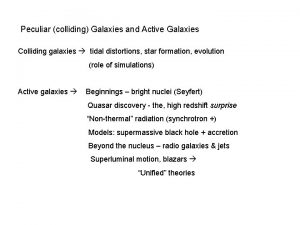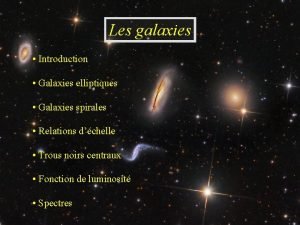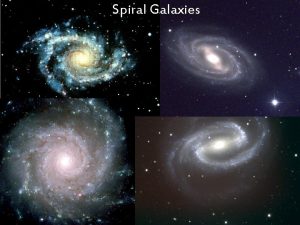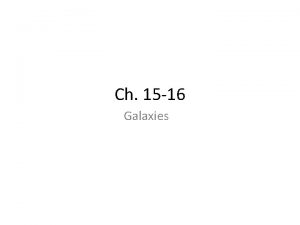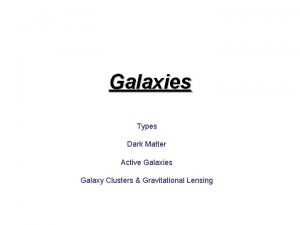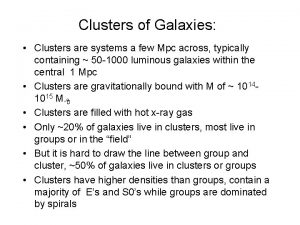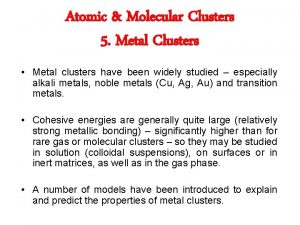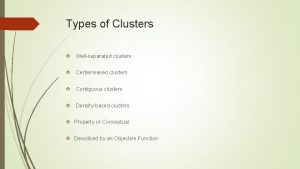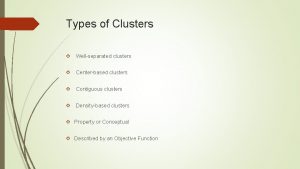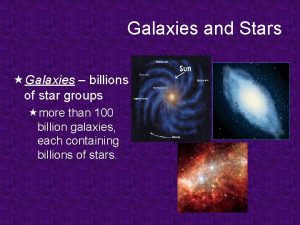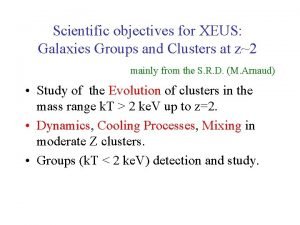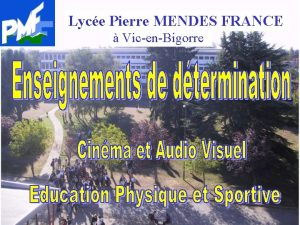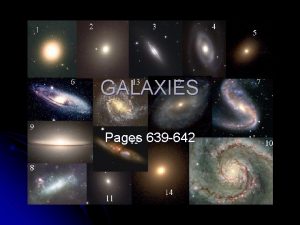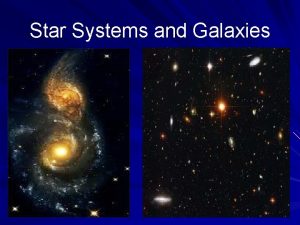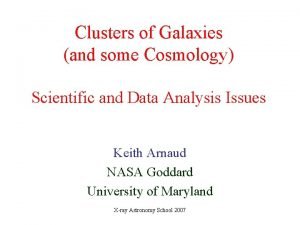Clusters and groups of galaxies Claudia Mendes de
















































































- Slides: 80

Clusters and groups of galaxies Claudia Mendes de Oliveira Instituto Astronômico e Geofísico Sao Paulo, Brazil

Plan of this class Why study clusters of galaxies A bit of history Galaxy morphological classification Local group, Virgo cluster, Coma cluster Cluster catalogues Populations of galaxies in nearby clusters Luminosity functions of galaxies in clusters c. D galaxies Dwarf galaxies Cluster kinematics Some physical processes which can affect galaxies in clusters Measuring the masses of clusters

A bit of history Charles Messier published his famous catalogue of nebulae in 1784. He noted that: “The constellation of Virgo… is one of the constellations that contains the greatest number of nebulae” Other similar concentrations of nebulae were found in the 18 th and 19 th centuries by the Herschels. William Herschel (1785) commented on: “That remarkable collection of many hundreds of nebulae which can be seen in what I call the nebulous startum of Coma Berenices” Other clusters of nebulae were discovered by: Wolf (1902, 1906), Lundmark (1927), Baade (1928), Christie (1929), Hubble and Humason (1931), Shapley (1934)

Determination of distances Hubble Constant Redshift

Why study clusters of galaxies? 1. 2. 3. 4. 5. Clusters are the largest objects in the universe to have reached a quasi-equilibrium state. Clusters provide excellent laboratories to study galaxy formation, evolution and interactions. Clusters provided the first and best evidence of vast quantities of dark matter in the universe. Clusters have provided important insights into a wide range of topics, such as high-energy astrophysics, particle physics, cosmology, etc… Clusters can be used to map the large-scale structure of the universe

10 arcmin From talk of M. Bergmann Crete 04 0. 5 Mpc 30 arcsec Perseus z=0. 018 RXJ 0152. 7 -1357 z=0. 83

The Coma Cluster Only 10% of the mass is visible (gas and stars)

The Cfa Slice Lei de Hubble e d a d i c Velo d=v/Ho De Lapparent et al. 1988

Large scale structure – 2 d. F

Model – lambda cold dark matter This image shows the hierarchical clustering in computer Simulation for lambda CDM models. The smallest structures visible are of cluster size. Clusters are still forming today! Many of them may therefore not be virialized.

Very important Galaxy clustering is a continuous hierarchy Any attempt to identify individual clusters requires rather arbitrary and subjective boundaries to be drawn. There is no unique and unambiguous definition of what constitutes a cluster of galaxies, and thus no single method of identifying them. For this reason, studies of clusters and their properties depend on the methods used to identify and catalogue them.

Morphological classification of galaxies

An irregular galaxy

A spiral galaxy Surface brightness profile of M 33: V~31 mag arcsec -2 Ferguson et al. 2004

Spectrum dominated by the Emission of young stars Spectrum of a spiral Galaxy with SF

A lenticular (or S 0) galaxy

Elliptical galaxy R 1/4

Spectrum of an old eliptical galaxy, no SF Through the line indices one can infer ages, metallicities and abundances

From the talk of H. Kuntschner, Crete Aug 2004

Merging of two spirals can form an elliptical galaxy

The Local Group It has about 40 member galaxies. But several more dwarf galaxies may be undetected (particularly behind the Milky Way). The three main galaxies of the Local Group are our own Milky Way, M 31 and M 33, all spirals. Most of the galaxies are dwarf galaxies. There are no elliptical galaxies in the Local Group except for M 32 (not a typical elliptical). The total mass of the Local Group is about 5 x 1012 solar masses. Small groups like the Local Group are the most common type of systems in the Universe

The Local Group Majewski et al. (2003)

The Virgo Cluster ● ● ● It is 15 Mpc from Earth It has several thousand galaxies 70% of galaxies are spirals The distribution of galaxies is clumpy The LC is infalling towards Virgo

The Virgo cluster

The Virgo cluster

The Coma Cluster ● ● Distance: 70 Mpc (z=0. 02) Brightest members are ellipticals ~ up to 10000 members Best-studied of all clusters

The Coma Cluster Coma provided the first evidence of dark matter in clusters Total cluster mass of 1015 solar masses

Cluster catalogues



Zwicky et al. (1961 -1968) Zwicky catalogued about 10000 clusters by eye Because a less rigorous cluster definition was used, this catalogue is not as complete or homogeneous as Abell's An Shectman (1985) An automated computer procedure was used to identify 646 clusters from the Lick galaxy survey

Edinburgh-Durham Cluster Catalog (Lumsden et al. 1992) An automated procedure based on Abell's cluster definition was used 737 clusters were identified in the southern sky An APM Cluster Catalog (Dalton et al. 1992) – – A different automated procedure was used Galaxies were counted within r=0. 075 h-1 Mpc Different magnitude range 220 clusters were cataloued 2 d. F and SDSS cluster surveys - several

X-ray galaxy cluster surveys BCS, XBCS, REFLEX, EMSS, PSPC SHARC, WARPS, MACS An

Flux limits of X-ray cluster catalogues Ebelingetetal. 2001 Ebeling 2001

Observations of galaxies in clusters Richness is a measure of the total number of galaxies that belong to a cluster. “Rich” vs. “Poor” cluster It is very difficult to determine the total galaxy populations of a cluster because: 1) it depends on the mag. limit to which one counts 2) clusters don't have clear boundaries 3) There is contamination from foreground and background galaxies

➔ Density Profiles Density profiles provide information on the radial mass distribution, which can be related to theories of cluster formation.

➔ Density Profiles Wiggles in the profile suggest substructure is present.

➔ Density Profiles �Several different functional forms have been propos describe density profiles. Often more than one can fit the data. (r) = r (power – law profile) (r) = exp [-7. 67(r/re) ¼] (de Vaucouleurs profile) (r) = [1+(r/rc)] (Hubble profile) (r) = o[1+(r/rc) 2] (King profile)

Observations of galaxies in clusters – Galaxy distributions in clusters show a wide range of morphologies, from smooth centrally-condensed to clumpy with no well-defined centroid. Many clusters are very elongated.

Substructures Many clusters ( about 50% or more) show substructure Dynamical evolution will rapidly erase substructure. Therefore its prevalence indicates that many clusters have formed fairly recently. If clusters are dynamicaly young, they may still carry clues about their initial conditions at the time of formation.

Observations of galaxies in clusters – Galaxy populations The mixture of different galaxy types varies widely from cluster to cluster Poor clusters have a greater fraction of S and Irr. Rich clusters have a greater percentage of elliptical galaxies.

Morphology – density relation Galaxy type correlates with density; ellipticals are found preferentially in high-density regions

Morphology clustercentric-distance relation Galaxy type correlates with position; ellipticals are found preferentially near the cluster center. Whitmore et al. 93

The colour-magnitude diagram (Ellis et al; Kodama et al; Gladders et al) Clusters present the redsequence, at low and intermediate redshifts color ● magnitude

Implications of the Color-magnitude relation of clusters 1. 2. 3. Lopez-Cruz et al. (2004) studied the CMR for 57 X-ray detected Abell clusters “ Models that explain the CMR in terms of metallicity and passive evolution can naturally reproduce the observed behavior of the CMRs studied” “The observed properties of the CMR are consistent with models in which the last episode of strong star formation in […] early-type galaxies in clusters were formed more than 7 Gyg ago”

The luminosity function of galaxies in clusters ● Count number of galaxies in each bin of magnitudes

The luminosity function of galaxies in clusters

The luminosity function of galaxies in clusters

The luminosity function of galaxies in clusters The luminosity function is usually welldescribed by a Schechter form: Where (L)= t he number of galaxies with luminosities L to L+d. L L* = 1 x 1010 h-2 solar luminosities = -1. 0 to -1. 5 = 0. 03 h 3 Mpc-3

The luminosity function of galaxies in clusters The Schechter function, in terms of magnitudes is:

➔ Luminosity function What are M* and ? The value of indicates the dwarf content of the cluster For steep faint-end, < -1 , the system is rich in dwarfs For a flat faint-end = -1 For a declining faint-end > -1, few dwarfs M* is the knee of the function at the bright end

The Coma cluster LF – Berstein et al. 1995

Coma Luminosity function Mobasher et al. (2003) Over 700 galaxies with measured redshifts down to MB=-16 They find a flat luminosity function with alpha of approx. -1

LF for Coma galaxies Faint end is steeper if red galaxies are selected Mosbaher et al. 2003

LF for Virgo galaxies Faint end with =- -2 (Phillips et al. 1998) not confirmed by more recent studies Trentham et al. 2002 = -1. 6

The Cold Dark Matter´s Small Scale Crisis Moore et al. 1999

c. D galaxies c. Ds are the largest galaxies in the universe, surrounded by faint envelopes which may extend for many hundreds of kpc. They are found in the centers of clusters and of a few groups They may have formed by galaxy canibalism or by accretion of tidally-stripped material from other galaxies c. D galaxies are often oriented in the same direction as the major axis of the cluster in which they reside Originally studied to determine cosmological parameters (e. g. Sandage et al. 1972) and measure large-scale streaming motions (e. g. Lauer and Postman 1994).

c. D galaxies

c. D galaxies

● ● ● Monolithic collapse models predict that these galaxies formed first at very high redshift and have passively evolved since. Hierarchical models predict that these most massive galaxies should have assembled their stellar mass most recently. Therefore, the differences in the predictions of these models should be most apparent in these, most massive galaxies.

Brough et al. (2005) studied a sample of BCGs from x-ray cluster samples. Their results are: 1. BCGs in high X-ray luminosity clusters assembled their stellar mass at z>1 and have been passively evolving since. 2. BCGs in low X-ray luminosity clusters have assembled more recently and have been undergoing significant mass evolution since z~1. 3. BCG profiles not consistent with those of normal cluster elliptical galaxies.

Dwarf galaxies d. E/d. Sp galaxies are the most abundant type in the universe. The ratio of dwarf/giant galaxies increases from field to group and to rich cluster. In the cores of clusters, d. Sphs may be easily destroyed by the mean tidal field of the cluster.

Dwarf galaxies

Milky way dwarfs at the distance of the Virgo cluster

Cluster kinematics – known long ago… In a cluster of galaxies the only important force acting between the galaxies is gravitation. It is the pulling of the galaxies on each other that gives rise to their velocities. The more mass in the cluster, the greater the forces acting on each galaxy (the higher the relative velocities). If the velocity of a given galaxy is too large, it will be able to escape the cluster. Therefore, by knowing that all of the galaxies have velocities of less than the escape velocity, one can estimate the total mass of a cluster. In the 30’s, Zwicky and Smith examined the individual galaxies making up two nearby clusters (Coma and Virgo). What they found is that the velocities of the galaxies were about a factor of ten to one hundred larger than they expected.

Cluster kinematics Clusters are not static systems. Their galaxy populations are in contant motion. The speed of galaxies in clusters is characterised by the line-of-sight velocity dispersion If the galaxy orbits are isotropic, then:

Cluster kinematics Velocity Distribution In the Coma Cluster (552 Velocities) Coless and Dunn (1996)

Cluster kinematics The shape of the velocity distribution gives information about the dynamical state of the cluster. Significant deviations from Gaussian may indicate nonisotropic orbits or subclustering. These can be measured from moments of the velocity distribution. 1 st moment = <v> 2 nd moment = 3 rd moment = 4 th moment =

Cluster kinematics In practice, many hundreds of velocities must be measured before we can really understand cluster dynamics! Contamination from foreground/background galaxies is a big problem.

How to weigh a cluster of galaxies: the Virial Theorem A self-gravitating system in a steady-state will satisfy the virial theorem: 2 T+U=0, where T=kinetic energy and U=potential energy. Hence,

The observed cluster mass function (Girardi et al. 1998): Substructure has only a minor effect on virial masses

Physical processes which can affect galaxies in clusters

Physical processes affecting cluster galaxies Ram pressure stripping (Gunn and Gott 1972, Quilis et al. 2000) Tidal effects, mergers and accretion (Toomre and Toomre 1972, Bekki 2001, Aguerri et al. 2001) Harassment (Moore et al. 1996, Mastropietro et al. 2004) – Transformation of a late-type spiral galaxy into a dwarf galaxy through interactions between cluster galaxies and with the gravitational cluster potential

Interaction of a galaxy with the cluster environment ● ● ● Gravitational interaction galaxy - cluster Gravitational interaction galaxy - galaxy Ram pressure galaxy ISM – intracluster medium (ICM) (Böhringer et al. 1994 (Kenney et al. 1995) (Kenney et al. 2004)

Star forming ring around an interacting galaxy 3 Mpc NGC 4522 (Cayatte et al. 1990)

Spiral galaxies in the Virgo cluster 3 Mpc NGC 4522 (Cayatte et al. 1990)

NGC 4438 Color: optical B band Spectra: IRAM 30 m CO(1 -0) (Kenney et al. 1995) (Vollmer et al. 2004)

NGC 4438 Grey: gas Contours: stars


Summary Clusters of galaxies are a very diverse class of objects Many (50% or more) of clusters show significant substructure in their galaxy distributions. Galaxy populations span an enormous range of luminosities and morphological mixtures. Galaxy populations may have evolved significantly over the last few billion years. The distribution of galaxy velocities can provide information on the dynamical state of a cluster. Cluster masses can be measured from the virial theorem. Cluster masses range from 1013 -1015 solar masses. Galaxies account for only 5 -10% of this mass, and hence most of the cluster mass must be dark.
 Electromagnetic star
Electromagnetic star Chapter 30 galaxies and the universe
Chapter 30 galaxies and the universe Galaxie s
Galaxie s How are ethnic groups and religious groups related
How are ethnic groups and religious groups related Life cycle of a galaxy
Life cycle of a galaxy Facts about elliptical galaxies
Facts about elliptical galaxies Classification
Classification Era of galaxies
Era of galaxies Milky way galaxy shape
Milky way galaxy shape What are galaxies
What are galaxies Brainpop galaxies quiz answers
Brainpop galaxies quiz answers 4 types of galaxies
4 types of galaxies How are galaxies classified? *
How are galaxies classified? * Tipus de galaxies
Tipus de galaxies Properties of elliptical galaxies
Properties of elliptical galaxies Evolution of galaxies
Evolution of galaxies Universe pg
Universe pg Galaxies lesson plan
Galaxies lesson plan K damas
K damas Características da dor
Características da dor Casa butanta
Casa butanta Teoria melanesica
Teoria melanesica Lycee pierre mendes france vitrolles
Lycee pierre mendes france vitrolles Ernie mendes
Ernie mendes Aristides de sousa mendes angelina ribeiro
Aristides de sousa mendes angelina ribeiro The butterfly circus characters
The butterfly circus characters Dr silva mendes
Dr silva mendes Luciana corts mendes
Luciana corts mendes Pierre mends
Pierre mends Dr fernando moura oncologista
Dr fernando moura oncologista Sabine mendes
Sabine mendes Randi mendes
Randi mendes Mendes definition
Mendes definition Enrichment clusters
Enrichment clusters Jmu nursing course planning worksheet
Jmu nursing course planning worksheet Missouri connections career clusters
Missouri connections career clusters Four major population clusters
Four major population clusters Cocci in grape-like clusters
Cocci in grape-like clusters 15 grand strategies with examples
15 grand strategies with examples Obsessive personality disorder
Obsessive personality disorder Mapreduce: simplified data processing on large clusters
Mapreduce: simplified data processing on large clusters High performance linux clusters
High performance linux clusters Marking bad clusters data hiding technique
Marking bad clusters data hiding technique What are five reasons expressways have fewer collisions
What are five reasons expressways have fewer collisions Difference between a vowel and a consonant
Difference between a vowel and a consonant Design objectives of computer clusters
Design objectives of computer clusters Four major population clusters
Four major population clusters Career cluster definition
Career cluster definition Danielson clusters
Danielson clusters Fcs lanchpad
Fcs lanchpad Maximal onset principle
Maximal onset principle Define career cluster
Define career cluster Noun cluster adalah
Noun cluster adalah Wave graphic organizer
Wave graphic organizer Types of waves quad clusters answer key
Types of waves quad clusters answer key Virtualization of clusters in cloud computing
Virtualization of clusters in cloud computing Mcis career clusters
Mcis career clusters Career clusters framework
Career clusters framework Rit cs clusters
Rit cs clusters Mcis career clusters
Mcis career clusters Why are career clusters important
Why are career clusters important 16 career cluster
16 career cluster Lower brain level
Lower brain level Empty space between traffic clusters
Empty space between traffic clusters Georgia career clusters
Georgia career clusters F5len web cluster
F5len web cluster Iseek career cluster interest survey
Iseek career cluster interest survey Maryland career clusters
Maryland career clusters Cluster b personality disorder traits
Cluster b personality disorder traits Onet career clusters
Onet career clusters Two almond shaped neural clusters
Two almond shaped neural clusters Mn career clusters
Mn career clusters Galaxy clusters
Galaxy clusters Galaxy clusters
Galaxy clusters Two almond shaped neural clusters
Two almond shaped neural clusters Mapreduce simplified data processing on large clusters
Mapreduce simplified data processing on large clusters Types of waves quad clusters
Types of waves quad clusters Rocks clusters
Rocks clusters Galaxy clusters
Galaxy clusters Mn career clusters
Mn career clusters Complete link clustering
Complete link clustering




